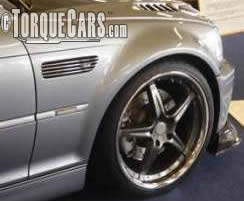lighter wheel will improve handling - less weight is rotating around the hub so components such as suspension and even brakes will last longer. The gaps in alloy wheels also aid brake cooling and allow the brakes to do a better job at slowing up the car.
Big wheels look really cool but I have not found anyone yet who says that they have improved the ride or handling of their car – keep the overall wheel width with tyre dimension as the OEM provided but go for a larger alloy and ultra low profile tyre if you really want the big wheel look. Lower profile tyres are noisier and due to their low flexing they give excellent handling characteristics.
Wider alloys are much better than taller ones and improve the handling. Many users complain that taller wheels affect the speed and handling adversely and cause tramlining and bumpy rides.
If you are contemplating alloy wheels try to keep the overall rotational diameter the same. If the rotational distance is larger (taller wheel size) then you will need to get your speedo recalibrated a 10% larger rotational diameter means that each mile you cover is 10% shorter and each mile per hour you are doing is 10% out - I'm building a calculator to suggest alloy wheel and tyre sizes to match your existing rotational diameter join the club to be one of the first to use it. Bigger wheels are often heavier so you should compare the weights of alloy wheels with the standard wheels you have. A rotating wheel will have a gyroscope effect and resist a change of direction so handling can be slightly affected with different wheels. Low profile tyres also increase grip, but the ride is harder and the tyres are more expensive. 
Some alloys are designed to be light weight (they can snap more easily though) and have a pattern that increases the airflow to the brake disks aiding your breaking efficiency. When you buy an alloy you need to check the pattern of nuts matches your car (Obviously!) PCD, you also need to check the offset and bore measurements. The last thing you want is the wheel not fitting properly over your brake disks or a wheel that grinds into the arches when you hit a bump or turn a corner. You may need to get your arches rolled or cut. Anything other than the original rotational dimensions will definitely require suspension adjustments. You should always get your camber, toe in/out and other suspension components checked for alignment when you change tyres, alloys, or hit a curb or bump that jolts the car.
Fact of life - ALLOY WHEELS GET CURBED. Choose a pattern that will not stick out too much and hit the curb (split rims are good for this). If the alloys have a chrome finish they can cost a fortune to get refurbished but look dreadful when scratched.
Summary: Keep the rotational diameter the same. Buy alloys for performance based on weight and brake cooling. Buy alloys for aesthetics based on their longevity and try to get an alloy pattern that will curb gracefully. (When you get the tyre balanced ask for the weights to go on the inside - so many national 'MrFastFit' tyre retailers stick them on the outside like ears - ruining everything you have tried to aesthetically achieve.)
No comments:
Post a Comment